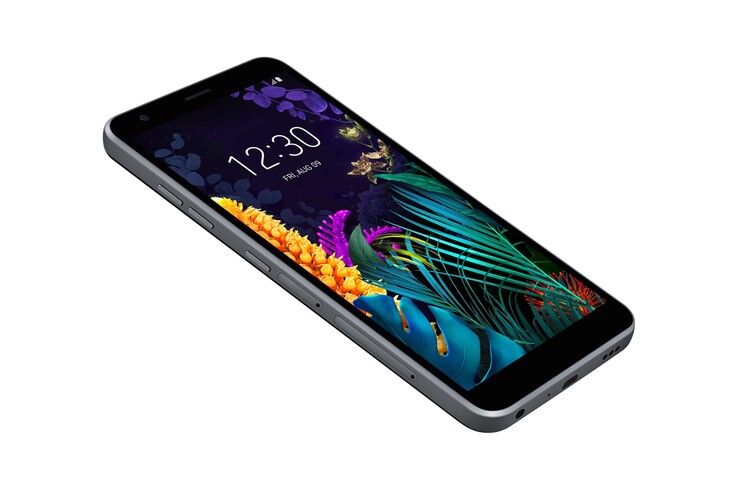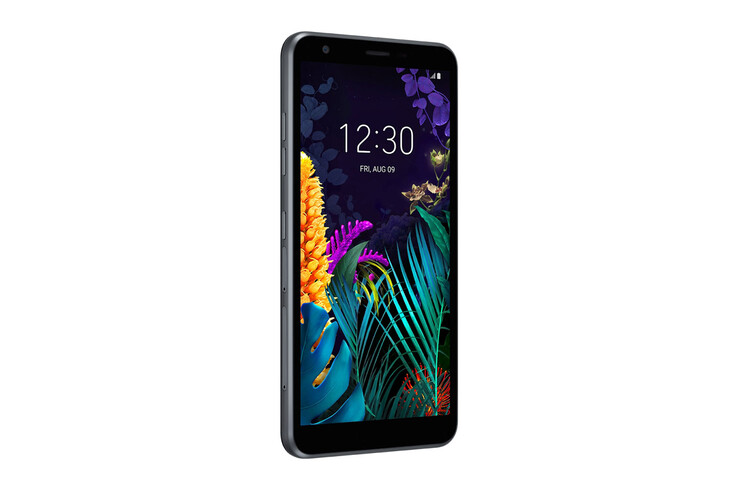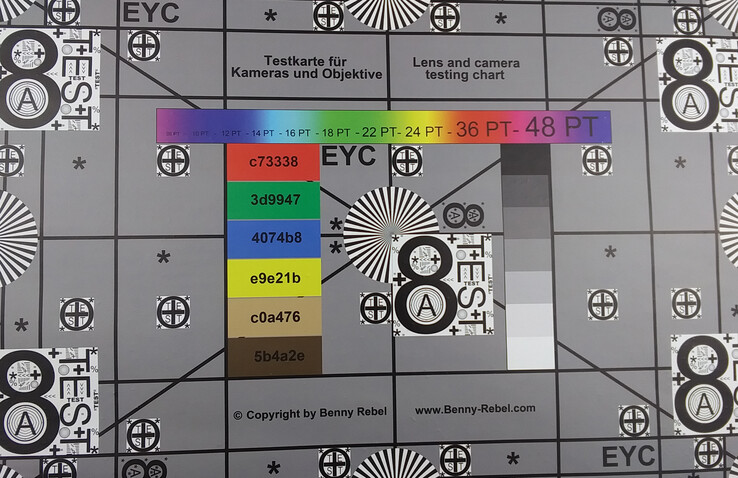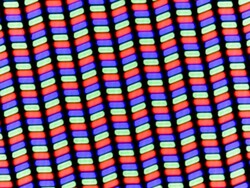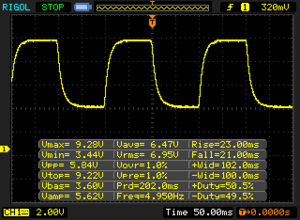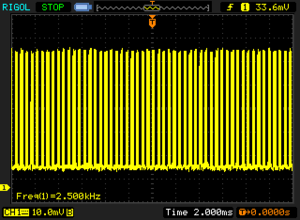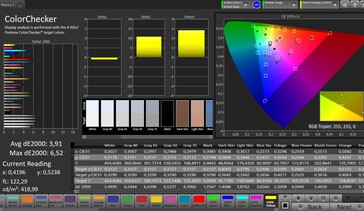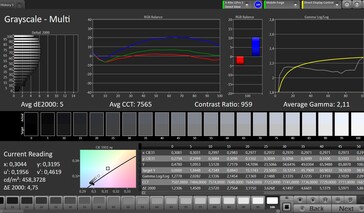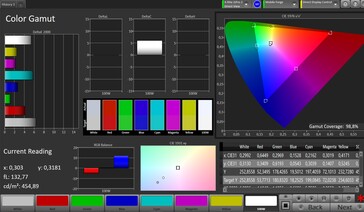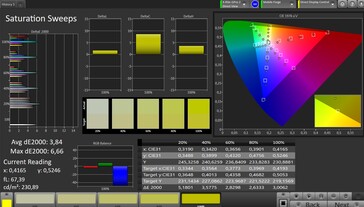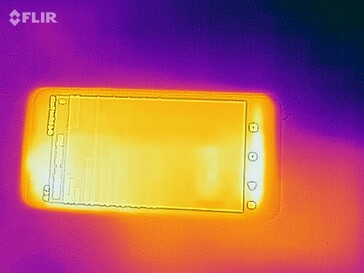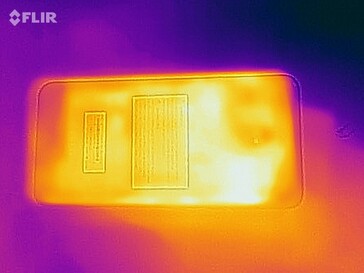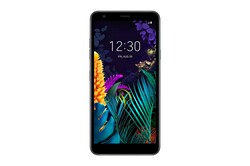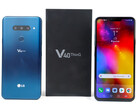LG K30 Smartphone Review – Cheap smartphone without bells and whistles
Comparison Units
Bewertung | Rating Version | Datum | Modell | Gewicht | Laufwerk | Groesse | Aufloesung | Preis ab |
|---|---|---|---|---|---|---|---|---|
| 69.8 % v7 (old) | v7 (old) | 11 / 2019 | LG K30 425, Adreno 308 | 148 g | 16 GB eMMC Flash | 5.45" | 1440x720 | |
| 72.8 % v7 (old) | v7 (old) | 06 / 2019 | Huawei Y5 2019 Helio A22 MT6761, PowerVR GE8300 | 146 g | 16 GB eMMC Flash | 5.71" | 1520x720 | |
| 74.9 % v7 (old) | v7 (old) | 11 / 2019 | Motorola Moto E6 Plus Helio P22 MT6762, PowerVR GE8320 | 149.7 g | 32 GB eMMC Flash | 6.10" | 1560x720 | |
| 74.9 % v7 (old) | v7 (old) | 08 / 2019 | Samsung Galaxy A10 Exynos 7884B, Mali-G71 MP2 | 168 g | 32 GB eMMC Flash | 6.20" | 1520x720 | |
| 82.6 % v6 (old) | v6 (old) | 08 / 2019 | Xiaomi Redmi 7A SD 439, Adreno 505 | 165 g | 16 GB eMMC Flash | 5.45" | 1440x720 |
Case, Equipment and Operation - Compact form factor
The LG K30 is not dissimilar to the Xiaomi Redmi 7A in terms of size and features and thus has a tough competitor. The case of both smartphones is still a bit old-fashioned with wide edges at the top and bottom and without notch. The LG smartphone is made of sturdy plastic and quite resistant, but it creaks audibly when twisted. According to the manufacturer it is certified according to MIL-STD810, although you should be careful here: The tests are not standardized and can be done by the manufacturer himself, so they don't say much about the resistance against humidity or impact. They should not be confused with real waterproofing. The smartphone is relatively compact and lightweight.
2 GB RAM and 16 GB mass memory are common in this class, but some devices already come with 32 GB mass memory, which is much longer than the limited memory of our test device. With microSD you can at least increase the space a bit. The smartphone also gets along with two SIM cards. Some advertising apps are pre-installed and can only be deactivated, which is a shame in view of the limited storage space. When it comes to WLAN, the speeds are average. There are only the most necessary LTE frequencies.
The touchscreen is not super-sensitive, but sufficiently sensitive for daily use, and there are occasional slight jerks. LG also offers a separate button for the Google Assistant for the cheap phones, which unfortunately can't be freely assigned. There is no fingerprint sensor and no face recognition.
| Networking | |
| iperf3 transmit AX12 | |
| LG K30 | |
| Huawei Y5 2019 | |
| Xiaomi Redmi 7A | |
| Samsung Galaxy A10 | |
| Motorola Moto E6 Plus | |
| iperf3 receive AX12 | |
| Motorola Moto E6 Plus | |
| Huawei Y5 2019 | |
| Xiaomi Redmi 7A | |
| LG K30 | |
| Samsung Galaxy A10 | |
Cameras - The essentials on board
Everything looks a little gloomy on the pictures of the main camera, which resolves with 8 megapixels. There's not much special equipment here, except for an LED flash. In the details, the pictures quickly appear noisy, the detail rendering is moderate and the pictures have a rather bluish hue. In dark areas there is a lack of brightening. In very low light, details are only rendered muddy.
Videos can be recorded in 1080p at 30 fps. Here the picture quality is OK, but it sometimes takes a few seconds until the camera starts filming and the autofocus is not the fastest either. Brightness transitions occur in visible brightness levels.
The front camera has a resolution of 5 megapixels, it is sufficient for snapshots and social media selffies, but in detail the pictures are unclean, have a blue cast and tend to color noise.
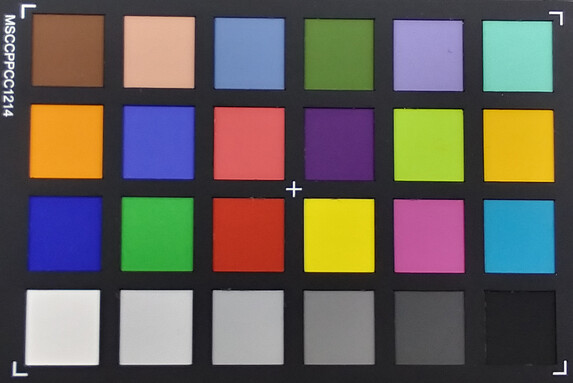
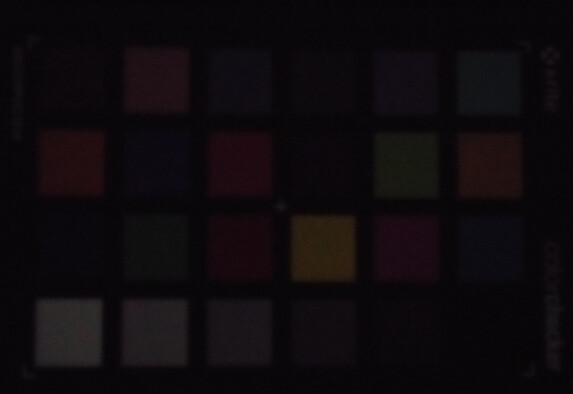
Display - Bright enough
With an average of 456 cd/m², the LG K30's IPS screen is bright enough for most environments, but there are also much brighter devices that are better suited for outdoor use, such as the Huawei Y5 2019. The black level and contrast are at a medium level for the class.
Colors have a distinct blue cast on the screen, but are surprisingly accurately displayed, so that you can at least roughly determine the printing colors of holiday photos on the display.
We do measure PWM, but with such a high frequency that nobody should notice it. The reaction times are also mediocre, at least for this price class.
| |||||||||||||||||||||||||
Brightness Distribution: 91 %
Center on Battery: 460 cd/m²
Contrast: 979:1 (Black: 0.47 cd/m²)
ΔE ColorChecker Calman: 3.91 | ∀{0.5-29.43 Ø4.78}
ΔE Greyscale Calman: 5 | ∀{0.09-98 Ø5}
98.8% sRGB (Calman 2D)
Gamma: 2.11
CCT: 7565 K
| LG K30 IPS, 1440x720, 5.5" | Huawei Y5 2019 IPS, 1520x720, 5.7" | Motorola Moto E6 Plus IPS, 1560x720, 6.1" | Samsung Galaxy A10 IPS, 1520x720, 6.2" | Xiaomi Redmi 7A IPS, 1440x720, 5.5" | |
|---|---|---|---|---|---|
| Response Times | 37% | -15% | 24% | 18% | |
| Response Time Grey 50% / Grey 80% * (ms) | 44 ? | 30 ? 32% | 53.6 ? -22% | 38 ? 14% | 32 ? 27% |
| Response Time Black / White * (ms) | 24 ? | 14 ? 42% | 26 ? -8% | 16 ? 33% | 22 ? 8% |
| PWM Frequency (Hz) | 2500 ? | 1000 ? | 77 ? | 384.6 ? | |
| Screen | -14% | 5% | -3% | -22% | |
| Brightness middle (cd/m²) | 460 | 630 37% | 453 -2% | 451 -2% | 533 16% |
| Brightness (cd/m²) | 456 | 593 30% | 440 -4% | 430 -6% | 506 11% |
| Brightness Distribution (%) | 91 | 88 -3% | 86 -5% | 90 -1% | 88 -3% |
| Black Level * (cd/m²) | 0.47 | 0.66 -40% | 0.14 70% | 0.22 53% | 0.6 -28% |
| Contrast (:1) | 979 | 955 -2% | 3236 231% | 2050 109% | 888 -9% |
| Colorchecker dE 2000 * | 3.91 | 5.79 -48% | 7.2 -84% | 5.44 -39% | 5.6 -43% |
| Colorchecker dE 2000 max. * | 6.52 | 9.54 -46% | 12.7 -95% | 11.94 -83% | 11.4 -75% |
| Greyscale dE 2000 * | 5 | 7 -40% | 8.4 -68% | 7.8 -56% | 7.4 -48% |
| Gamma | 2.11 104% | 2.176 101% | 1.95 113% | 2.206 100% | 2.212 99% |
| CCT | 7565 86% | 8420 77% | 8296 78% | 9149 71% | 7974 82% |
| Total Average (Program / Settings) | 12% /
-4% | -5% /
1% | 11% /
2% | -2% /
-14% |
* ... smaller is better
Display Response Times
| ↔ Response Time Black to White | ||
|---|---|---|
| 24 ms ... rise ↗ and fall ↘ combined | ↗ 9 ms rise | |
| ↘ 13 ms fall | ||
| The screen shows good response rates in our tests, but may be too slow for competitive gamers. In comparison, all tested devices range from 0.1 (minimum) to 240 (maximum) ms. » 53 % of all devices are better. This means that the measured response time is worse than the average of all tested devices (20.2 ms). | ||
| ↔ Response Time 50% Grey to 80% Grey | ||
| 44 ms ... rise ↗ and fall ↘ combined | ↗ 23 ms rise | |
| ↘ 21 ms fall | ||
| The screen shows slow response rates in our tests and will be unsatisfactory for gamers. In comparison, all tested devices range from 0.165 (minimum) to 636 (maximum) ms. » 73 % of all devices are better. This means that the measured response time is worse than the average of all tested devices (31.6 ms). | ||
Screen Flickering / PWM (Pulse-Width Modulation)
| Screen flickering / PWM detected | 2500 Hz | ≤ 10 % brightness setting | |
The display backlight flickers at 2500 Hz (worst case, e.g., utilizing PWM) Flickering detected at a brightness setting of 10 % and below. There should be no flickering or PWM above this brightness setting. The frequency of 2500 Hz is quite high, so most users sensitive to PWM should not notice any flickering. In comparison: 53 % of all tested devices do not use PWM to dim the display. If PWM was detected, an average of 8108 (minimum: 5 - maximum: 343500) Hz was measured. | |||
Performance, Emissions and Battery life
The Snapdragon 425 as SoC has gotten on in years and so it's not surprising that the LG K30 can't keep up with other current smartphones in the price range in terms of performance. The difference is sometimes very big with up to 89% in Geekbench. The LG K30 can be operated somewhat smoothly, but apps start with a noticeable delay and there are also occasional jerkers. Our reference microSD Toshiba Exceria Pro M501 is read and written quite quickly, otherwise the internal memory is rather slow.
The warming under load is only slightly noticeable. The small mono loudspeaker at the lower edge doesn't offer any bass or even deep mid-range. On the other hand, it sounds quite acceptable even with music, but speech is already very high at maximum volume.
From the 3,000 mAh battery, LG gets out almost 11 hours of battery life in our WLAN test, which is a rather moderate value, but in itself is sufficient for a working day, and with economical use also for 2. Charging takes quite a long time with almost 3 hours.
| PCMark for Android | |
| Work performance score (sort by value) | |
| LG K30 | |
| Huawei Y5 2019 | |
| Motorola Moto E6 Plus | |
| Samsung Galaxy A10 | |
| Xiaomi Redmi 7A | |
| Average Qualcomm Snapdragon 425 (MSM8917) (3681 - 5253, n=17) | |
| Work 2.0 performance score (sort by value) | |
| LG K30 | |
| Huawei Y5 2019 | |
| Motorola Moto E6 Plus | |
| Samsung Galaxy A10 | |
| Xiaomi Redmi 7A | |
| Average Qualcomm Snapdragon 425 (MSM8917) (2829 - 3831, n=18) | |
| LG K30 | Huawei Y5 2019 | Motorola Moto E6 Plus | Samsung Galaxy A10 | Xiaomi Redmi 7A | Average 16 GB eMMC Flash | Average of class Smartphone | |
|---|---|---|---|---|---|---|---|
| AndroBench 3-5 | 0% | 21% | 19% | -1% | -38% | 1696% | |
| Sequential Read 256KB (MB/s) | 261 | 272.1 4% | 277.7 6% | 296.4 14% | 258 -1% | 164.5 ? -37% | 2226 ? 753% |
| Sequential Write 256KB (MB/s) | 73.8 | 45.2 -39% | 106.1 44% | 101.7 38% | 68.7 -7% | 43 ? -42% | 1848 ? 2404% |
| Random Read 4KB (MB/s) | 53.1 | 62.1 17% | 61.7 16% | 73.4 38% | 57.8 9% | 21.7 ? -59% | 295 ? 456% |
| Random Write 4KB (MB/s) | 10.24 | 13.1 28% | 17.41 70% | 13.3 30% | 9.6 -6% | 8.08 ? -21% | 335 ? 3171% |
| Sequential Read 256KB SDCard (MB/s) | 85.6 ? | 81.8 ? -4% | 82.5 ? -4% | 78.8 ? -8% | 85.2 ? 0% | 59.1 ? -31% | |
| Sequential Write 256KB SDCard (MB/s) | 65.8 ? | 63.1 ? -4% | 62.3 ? -5% | 65.3 ? -1% | 64.6 ? -2% | 39.8 ? -40% |
Temperature
(+) The maximum temperature on the upper side is 38.4 °C / 101 F, compared to the average of 35.2 °C / 95 F, ranging from 21.9 to 247 °C for the class Smartphone.
(+) The bottom heats up to a maximum of 38.4 °C / 101 F, compared to the average of 34 °C / 93 F
(+) In idle usage, the average temperature for the upper side is 31.9 °C / 89 F, compared to the device average of 32.9 °C / 91 F.
Loudspeakers
LG K30 audio analysis
(±) | speaker loudness is average but good (79.5 dB)
Bass 100 - 315 Hz
(-) | nearly no bass - on average 39.9% lower than median
(+) | bass is linear (4.8% delta to prev. frequency)
Mids 400 - 2000 Hz
(±) | reduced mids - on average 7.8% lower than median
(±) | linearity of mids is average (10.6% delta to prev. frequency)
Highs 2 - 16 kHz
(+) | balanced highs - only 3.7% away from median
(+) | highs are linear (4.1% delta to prev. frequency)
Overall 100 - 16.000 Hz
(-) | overall sound is not linear (32.2% difference to median)
Compared to same class
» 82% of all tested devices in this class were better, 2% similar, 16% worse
» The best had a delta of 11%, average was 35%, worst was 134%
Compared to all devices tested
» 91% of all tested devices were better, 2% similar, 7% worse
» The best had a delta of 4%, average was 24%, worst was 134%
Samsung Galaxy A10 audio analysis
(+) | speakers can play relatively loud (86.1 dB)
Bass 100 - 315 Hz
(-) | nearly no bass - on average 75.4% lower than median
(+) | bass is linear (0% delta to prev. frequency)
Mids 400 - 2000 Hz
(-) | nearly no mids - on average 75.4% lower than median
(+) | mids are linear (0% delta to prev. frequency)
Highs 2 - 16 kHz
(-) | nearly no highs - on average 75.4% lower than median
(+) | highs are linear (0% delta to prev. frequency)
Overall 100 - 16.000 Hz
(-) | overall sound is not linear (123.3% difference to median)
Compared to same class
» 92% of all tested devices in this class were better, 7% similar, 1% worse
» The best had a delta of 11%, average was 35%, worst was 134%
Compared to all devices tested
» 98% of all tested devices were better, 2% similar, 0% worse
» The best had a delta of 4%, average was 24%, worst was 134%
Battery Life
| LG K30 3000 mAh | Huawei Y5 2019 3020 mAh | Motorola Moto E6 Plus 3000 mAh | Samsung Galaxy A10 3400 mAh | Xiaomi Redmi 7A 4000 mAh | Average of class Smartphone | |
|---|---|---|---|---|---|---|
| Battery Runtime | ||||||
| WiFi Websurfing (h) | 11 | 11.8 7% | 13.8 25% | 12.6 15% | 14.2 29% | 19.3 ? 75% |
Pros
Cons
Verdict - A newer SoC would have helped
If LG had used a slightly more modern SoC as the heart of the LG K30, the small smartphone would have held its own better against the tough competition. The positive aspects are that the exterior is quite stable and the smartphone is handy and compact. The WLAN is quite fast in the transmitting direction, but loses speed when receiving, as we found in our tests with the reference router Netgear Nighthawk AX12. The temperature development is within reasonable limits and the loudspeaker sounds at least passable when listening to music.
The screen is bright enough and quite true to color, even the blue tint is not as bad as on some competing devices. When it comes to cameras, there's what you need, you shouldn't expect miracles here, but rather acceptable image quality in bright light. The battery runtime is OK, but it can't inspire.
The LG K30 is cheap and compact, but its interior is outdated.
All in all, a smartphone that you can only really recommend at a lower price, for around 130 Euros, the competition offers significantly more battery life and performance.
LG K30
- 12/01/2019 v7 (old)
Florian Schmitt




